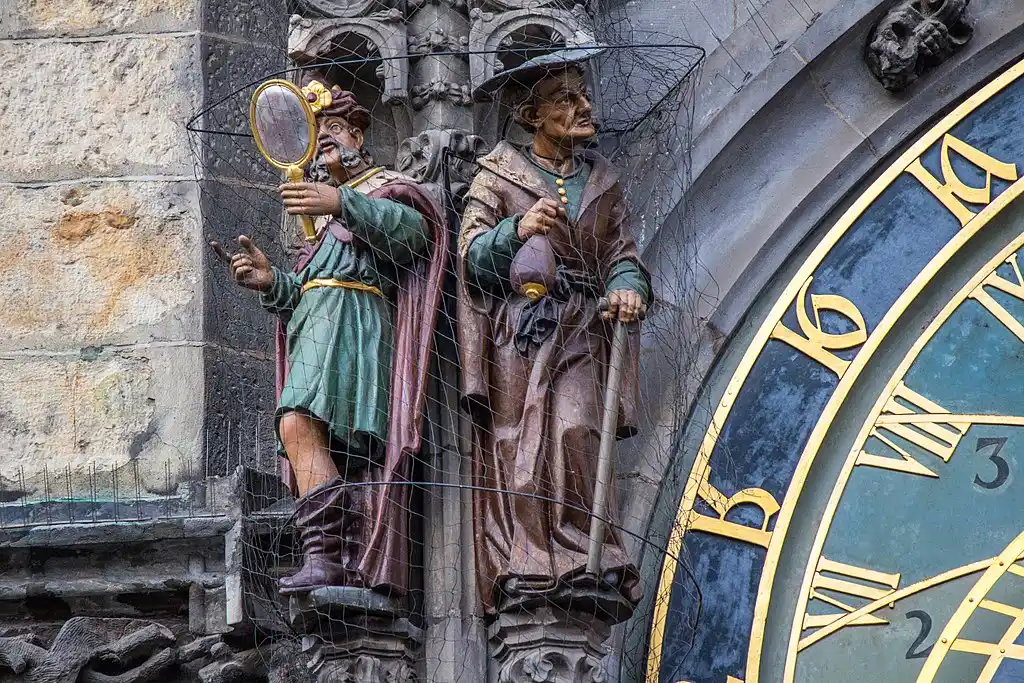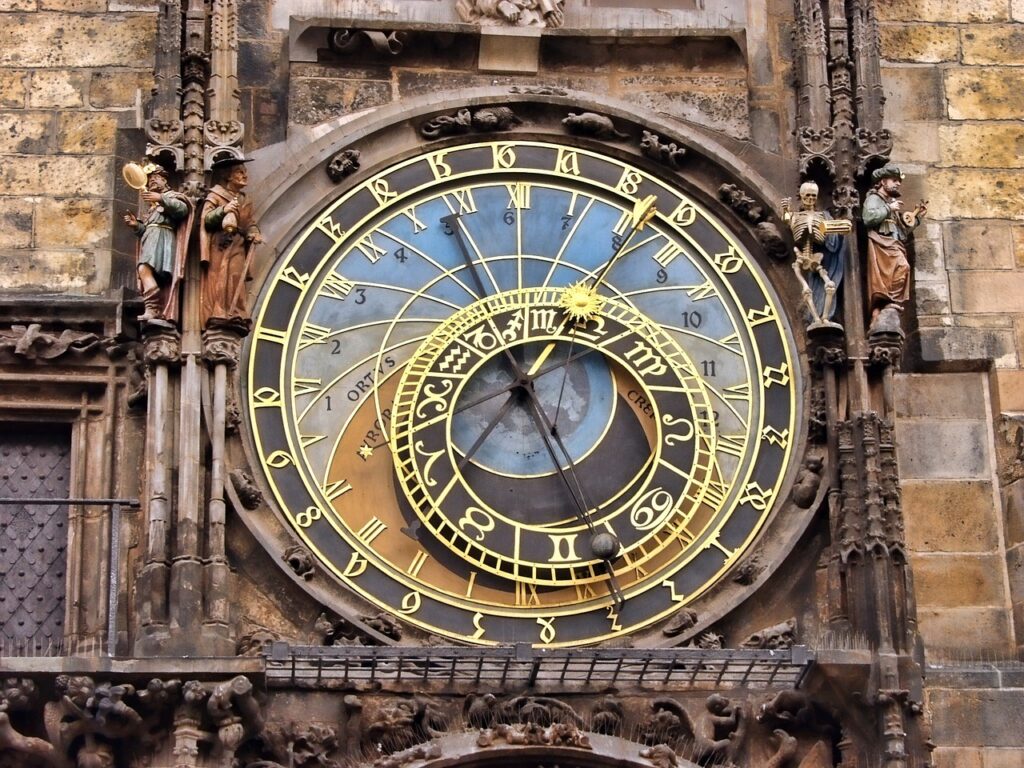Mounted on the southern wall of Prague’s Old Town Hall, the Astronomical Clock (Orloj) has been measuring the passage of time for over 600 years.
This remarkable medieval timepiece isn’t merely a clock—it’s a complex astronomical instrument, an intricate work of art, and a stage for a mechanical theater that has captivated spectators since the early 15th century.
With its combination of technical ingenuity, artistic beauty, and symbolic richness, the Orloj stands as one of the most impressive achievements of medieval science and craftsmanship in Europe, drawing visitors who gather at the top of every hour to witness its famous procession of Apostles.

The Birth of a Mechanical Wonder
The Astronomical Clock’s creation dates to 1410, when imperial clockmaker Mikuláš of Kadaň collaborated with Jan Šindel, a professor of mathematics and astronomy at Charles University, to bring this mathematical and mechanical marvel to life.
Their ingenious creation was one of the earliest and most sophisticated astronomical clocks in the world during an era when timekeeping itself was transforming European society.
What makes the Orloj extraordinary is that it doesn’t merely tell the time—it tracks astronomical information essential to a medieval society structured around religious observances and agricultural cycles. The clock’s astronomical dial represents the position of the sun and moon in the sky, showing ancient Czech time, Old German time, Babylonian time, and sidereal time.
It also indicates the zodiacal ring and the position of the sun within it, allowing medieval Praguers to determine the length of day and night and the current zodiac sign.
Legends, Death, and Blind Clockmakers
Like many Prague landmarks, the Astronomical Clock has accumulated legends over the centuries. The most dramatic tale claims that after Master Hanuš (sometimes incorrectly identified as the clock’s creator) completed the mechanism, the Prague councillors had him blinded to prevent him from building a similar clock elsewhere. In revenge, the story goes, the blind clockmaker reached into the clock’s mechanism and damaged it, ensuring no one could repair it.
While this gruesome tale captivates tourists, historical records tell us the clock was actually created by Mikuláš of Kadaň and has been maintained by a succession of skilled clockmakers through the centuries. Nevertheless, the legend speaks to the clock’s perceived uniqueness and value to the city’s identity.

Prague’s Astronomical Clock – Evolution Through the Centuries
The Orloj we see today is the product of centuries of modifications and restorations. In 1490, the calendar dial was added below the astronomical dial, featuring medallions representing the months of the year. The famous moving sculptures, including the procession of the Twelve Apostles visible through small windows above the clock face, were added during the major reconstruction of 1865-1866 by Josef Mánes, the celebrated Czech painter who also created the current calendar dial with its richly detailed scenes of Czech rural life throughout the year.
The clock has survived numerous threats throughout its history. During the Prague Uprising at the end of World War II in May 1945, the Old Town Hall was heavily damaged by Nazi fire, severely damaging the clock.
Black and white photographs from this period show the beloved Orloj in ruins, a potent symbol of the occupation’s destruction. The subsequent restoration, completed in 1948, became a symbol of Czech resilience and cultural continuity.
Most recently, the clock underwent a major restoration in 2018, during which the Apostle figures were repainted and the clock mechanism thoroughly cleaned and restored. This meticulous work ensured that the Orloj will continue its hourly performance for future generations of admirers.
The Astronomical Clock’s Hourly Performance
The clock’s famous hourly show begins with Death, represented by a skeleton, pulling a bell rope with one hand while holding an hourglass in the other, signifying that our time on earth is limited. Windows above the clock open, and the Twelve Apostles parade past, each identifiable by their traditional attributes. Meanwhile, other moving sculptures flanking the clock become animated: Vanity admires himself in a mirror, a miser clutches his bag of gold, a Turk shakes his head, and a proud figure nods arrogantly.
When the Apostles complete their procession, a golden rooster crows and flaps its wings, the hour strikes, and the bells chime. The entire spectacle lasts just 45 seconds but has delighted spectators for generations. While today’s tourists capture the moment on their smartphones, the performance would have seemed truly magical to medieval viewers unaccustomed to moving mechanical figures.
Experiencing the Astronomical Clock Today
Today’s visitors can enjoy the clock on multiple levels. The hourly show draws crowds to Old Town Square, where people gather expectantly, eyes fixed upward as the clock prepares to strike. For those seeking a deeper understanding, guided tours explain the clock’s astronomical functions and the symbolism of its various elements.
For an exceptional view of both the clock mechanism and Prague itself, visitors can climb the Old Town Hall tower, accessible via an elevator or the historic spiral staircase. From this vantage point, the clock’s intricate inner workings become visible, and the red-roofed panorama of Prague spreads out below.
Book Tickets to the City Hall and the Astronomical Clock >>
Specialized astronomical tours delve into the mathematical principles behind the clock’s design, while art history tours focus on the rich symbolism of the calendar dial, with its depictions of medieval life through the seasons. During significant holidays, especially Christmas and Easter, the square around the clock becomes even more magical as markets and festivities create a joyful atmosphere that connects present-day celebrations to centuries of Prague tradition.
A Symbol of Prague’s Technological Heritage
Beyond its role as a tourist attraction, the Astronomical Clock remains a profound symbol of Prague’s historical contributions to science, art, and technology. During an era when Prague was a center of alchemical and astronomical research under Emperor Rudolf II, the clock represented the city’s place at the forefront of European intellectual life.
Book Tickets to the City Hall and the Astronomical Clock >>
Join an Interesting Guided Tour in Prague’s Old Town >>
As Albert Einstein, who lived and worked in Prague in 1911-1912, reportedly remarked after observing the clock: “The medieval Astronomical Clock in Prague is a magnificent testament to human ingenuity that reminds us how our ancestors sought to measure and understand the cosmos with the tools of their time—proof that the quest to comprehend the universe is among humanity’s most enduring pursuits.”